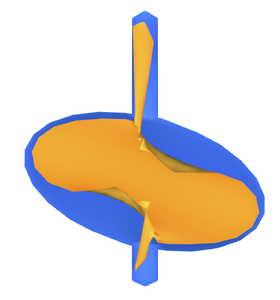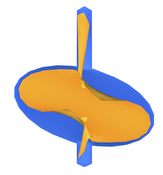Information
- Publication Type: Bachelor Thesis
- Workgroup(s)/Project(s):
- Date: February 2018
- Date (Start): November 2015
- Date (End): 22. February 2018
- Matrikelnummer: 1325669
- First Supervisor: Przemyslaw Musialski
- Second Supervisor: Michael Wimmer
- Keywords: geometry processing, shape optimization, blender plugin
Abstract
The advance of 3D printers’ capabilities and their sinking costs led to a huge trend of personal and commercial fabrication. But those advances were restricted to the hardware side meaning that there was a lack of software to optimize the digital models before printing. This was necessary because physical properties like mass, center of mass or moments of inertia, were neglected in the design of digital 3D models. Those properties play an important role in the behavior of a real-world object. Examples of an objects behavior are the ability to stand in a specific pose, float in the water or stably rotate around a certain axis. In the last few years methods have been presented to optimize digital models by altering specific regions of their volume in order to change their physical properties and therefore to prepare them for printing. A recently presented method forms the basis of this thesis. Due to its flexibility and performance it is well suited to be integrated into current 3D modeling applications. The algorithm was implemented as a C/C++ library which can be integrated in almost every application. Afterwards this library was integrated into the open source 3D modeling application Blender as a modifier.Additional Files and Images
Weblinks
No further information available.BibTeX
@bachelorsthesis{gersthofer-2016-sosob,
title = "Reduced-Order Shape Optimization Using Offset Surfaces in
Blender",
author = "Lukas Gersthofer",
year = "2018",
abstract = "The advance of 3D printers’ capabilities and their sinking
costs led to a huge trend of personal and commercial
fabrication. But those advances were restricted to the
hardware side meaning that there was a lack of software to
optimize the digital models before printing. This was
necessary because physical properties like mass, center of
mass or moments of inertia, were neglected in the design of
digital 3D models. Those properties play an important role
in the behavior of a real-world object. Examples of an
objects behavior are the ability to stand in a specific
pose, float in the water or stably rotate around a certain
axis. In the last few years methods have been presented to
optimize digital models by altering specific regions of
their volume in order to change their physical properties
and therefore to prepare them for printing. A recently
presented method forms the basis of this thesis. Due to its
flexibility and performance it is well suited to be
integrated into current 3D modeling applications. The
algorithm was implemented as a C/C++ library which can be
integrated in almost every application. Afterwards this
library was integrated into the open source 3D modeling
application Blender as a modifier. ",
month = feb,
address = "Favoritenstrasse 9-11/E193-02, A-1040 Vienna, Austria",
school = "Institute of Computer Graphics and Algorithms, Vienna
University of Technology ",
keywords = "geometry processing, shape optimization, blender plugin",
URL = "https://www.cg.tuwien.ac.at/research/publications/2018/gersthofer-2016-sosob/",
}

 thesis
thesis

